 Multiple Choice Questions
Multiple Choice QuestionsA BALB/ c mouse was thymectomized on the first day after birth (mouse 1) whereas another was thymectomized on day 7 after birth (mouse 2). A third mouse underwent the same operation on day 21 after birth. After 56 days, sera were prepared from these mice and also from control mice, which had sham operation. The sera were checked for anti-DNA antibodies. Which one of the following observations is the most plausible?
Both mouse 1 and mouse 2 had anti-DNA antibodies but mouse 3 did not have anti-DNA antibodies.
Only mouse 1 had anti-DNA antibodies.
Only mouse 3 had anti-DNA antibodies.
Only the control mice had anti-DNA antibodies.
A set of experiments that were carried out to demonstrate the effect of Apical Ectodermal Ridge (AER) of the chick limb bud on the underlying mesenchyme are enlisted below, along with their expected outcomes:
A. Removal of the AER of forelimb leads to cessation of limb development.
B. If an extra AER is placed in the forelimb bud, duplication of the distal region of the wing takes place.
C. If an extra AER is placed in the forelimb bud, a leg develops instead of a wing.
D. If AER of forelimb bud is replaced with beads soaked in FGF2, a normal wing develops.
E. If a nonlimb mesenchyme is placed below an AER, the AER directs the mesenchyme to form a normal wing.
Which of the above statements are correct?
A, C and E
C, D and E
B, D and E
A, B and D
D.
A, B and D
Among the given statements, statements that are correct are A, B and D.
Myoglobin (Mb) in muscles, Hemoglobin A (HbA) in adult RBC, Hemoglobin C (HbC) in patients with thinner RBC and Hemoglobin S (HbS) in sickle cell disease are four different hemoproteins. Oxygen saturation kinetics of these four proteins is different. Which of the following profile is most plausible?
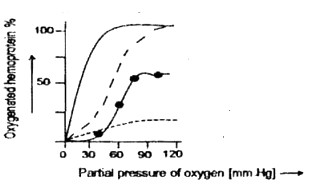
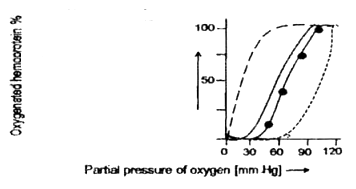
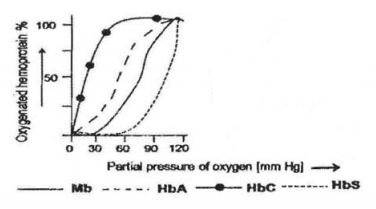
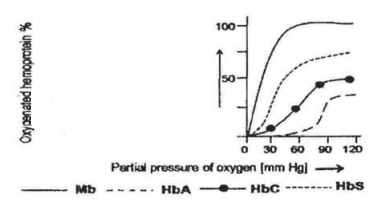
Ames test is used to evaluate mutagens in the environment. Which of the following statements about the Ames test are true?
A. The mutagenic effect of a compound is tested using an auxotrophic strain of Salmonella typhiurium.
B. The mutagenic effect of a compound is tested using His- strain of Eschirichia coil.
C. Using appropriate strains, compounds causing base substitutions and frame shift mutations can be distinguished.
D. Liver enzymes are important as they are activated by test compound to evaluate its mutagenicity potential.
E. Many compounds may have to be converted to bioactive metabolites, which is carried out by the enzymes from the liver.
A, C, and D
A, B, and D
A, C, and E
A and E
In resting cells, proteins X and Y are localized in the cytosol. upon stimulation with lipopolysaccharide (LPS), both of them are phosphorylated and translocate to the nucleus. You have used antibodies against phosphorylated forms of proteins X and Y which are conjugated to either red, or green or blue dye. Keeping optical aberration of light in mind, which one of the following will be the best for visualizing X and Y in the nucleus by fluorescence microscopy?
Anti green X and anti red Y
Anti red X and anti green Y
Anti red X and anti blue Y
Anti blue X and anti green Y
An unknown peptide was isolated from the leaf of a medicinal plant and purified to homogeneity. The peptide di not yield any sequence when subjected to Edman degradation. However, tryptic digest of the peptide produced a unique sequence. The mass of the intact peptide was found to be 18 Da less than that obtained from the trypsin treated sample. the possible interpretation of the above experimental results could be that the
A. the N-terminus of the peptide was blocked by acetylation or methylation.
B. the peptide was cyclic and contained at least one internal arginine or lysisne residue.
C. the peptide was cyclic and contained a lysine or arginine residue at the C-terminus.
D. the peptide was cyclized by peptide bond formation between α-amino group and α-carboxyl group.
Which of the above statements is true?
A and D
A and B
B and C
B and D
A gene is regulated by a novel transcription factor. the following techniques may be used to identify the cis-regulatory element in the 1 kb promoter sequence of the gene where the novel transcription factor binds:
A. Bioinformatics analysis.
B. Cell based reporter assay.
C. S1 nuclease assay.
D. Electrophoretic mobility shift assay
E. DNAse-1 foot-printing analysis
Which one of the following can help to identify the cis element?
A and B
C and E
D only
E only
A protein D is encoded by a gene, which is 5 Kb long and has three Hind III restriction enzyme sites. The first one is 0.5 Kb from the transcription start site, the second one if 2.5 Kb from the first site and the third one is 0.5 Kb internal to the stop codon. The second site is polymorphic. In order to find out whether fetal cells contain the normal or the mutated gene, total genomic DNA from fetal cells was isolated, completely digested with Hind III, separated in an agarose gel, transferred to membrane and detected by a probe against the region between the second and third restriction site. Which one of the following band patterns will be obtained if the fetal cell is heterozygous?
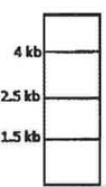
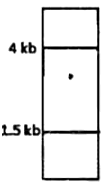
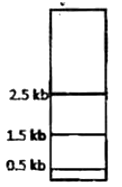
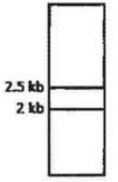
Given below are the experimental protocols to find out the exact location of repetitive DNA sequence in mitotic chromosome by FISH (Fluorescence in situ hybridization). Which one of the protocols will give the correct result?
Mitotic chromosomes were fixed on glass slide → incubated with biotinylated telomeric DNA → denatured → incubated with fluorescently labeled avidin → localization observed under a fluorescence microscope.
Mitotic chromosomes were fixed on glass slide → denatured → incubated with FITC labeled unrelated non-repetitive DNA sequence → counterstained with propidium iodide → localization observed under fluorescence microscope.a
Mitotic chromosomes were fixed on glass slide → denatured → incubated with biotinylated satellite DNA → incubated with fluorescently labeled avidin → localization observed under fluorescence microscope
Mitotic chromosomes were fixed on glass slide → incubated with repetitive DNA sequence binding protein → denatured → FITC labeled antibody against the protein → localization observed under fluorescence microscope.
At 25°C values of [θ]222, the mean residue ellipticity at 222nm, are -33,000 and -3,000 deg cm2 dmol-1 for a polypeptide existing in α-helical (α) and β-structure (β), respectively. If this polypeptide undergoes a two-state heat induced α → β transition, and a value of [θ]222 = -18,000 deg cm2 dmol-1 is observed at 60°C, then this observation leads to the conclusion that the α -helix conversion to β-structure is:
40%
50%
55%
60%
